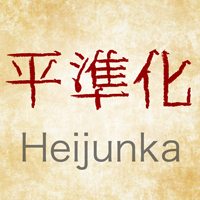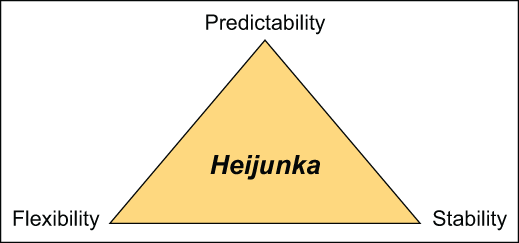Summary
What is Heijunka?
Heijunka is in the Lean concept that aims to smoothing the production schedule. By doing smoothing on the scheduling of, it will obtain advantages in the process of lead time.
The relation between Predictability, Flexibility
and Stability Is Heijunka – When implemented correctly, heijunka provides
predictability by leveling demand, flexibility by decreasing changeover time
and stability by averaging production volume and type in a long term.
Lean is a
management system that is fully focused on efficiency. Lean is "a
philosophy of long-term growth through efforts to increase value for customers,
society and economy in order to reduce costs, accelerate time to provide
interventions, and improve the quality through the elimination of waste in
total" (Boss and Frank, 2013: 170; Lean Interprise Institute, 2009 ). Lean discoursed first time in the automotive
industry by Toyota management system in the 1890s. since then, lean attracting
various industries in the world and applied in many aspects besides
manufacturing.
 |
| Taiichi Ohno was a
Japanese industrial engineer and businessman. He is considered to be the father of the Toyota Production System |

No mass production system can be continuously responsive to gyrating orders without suffering from muri (overburden of machines, managers, and production associates), and mura (unevenness in productivity and quality). And mura and muri together create muda (waste).

TPS around this by leveling the load and do not
always produce based on the order. This concept is known as heijunka; which is
based on the description above, can be interpreted as a system of
production-leveling that produces the right product mix as demanded by the
customer by making optimal utilization of the available capacity.
What Heijunka does?
- Stabilizes production volume and variety by consolidating total number of customer orders
- Spreads out the production in an even manner through-out the day
- Ensures high order fulfillment rate
- Ensures internal production is balanced
- Established capacity is not over or under-utilized
Adjust the production schedule of activities with
the aim to control inventory, reduce lead time, and producing diverse products
with a volume corresponding to the request is desired by consumers.
From Figure on the right it
is known that the characteristics of JIT, including:
From Figure on the right it is known that the characteristics of JIT, including:
- meet customer
demand right when there is demand (just-in-time);
- reducing
inventories of finished goods (finished goods);
- work schedule can
not be predicted; and
- suppliers are
located in the upper (upstreams) must have high variability in order to meet
customer demand variations.
And, production leveling characteristics, including:
- meet customer
demand based on the total production leveling specified period (in the case
above in the weekly);
- inventories of
finished goods (finished goods) is made for short-term periods which have high
demand;
- work schedule can
be predicted; and
- production stability is transmitted throughout the
supply chain (supply chain) to reduce inventory suppliers.
- meet customer demand right when there is demand (just-in-time);
- reducing inventories of finished goods (finished goods);
- work schedule can not be predicted; and
- suppliers are located in the upper (upstreams) must have high variability in order to meet customer demand variations.
- meet customer demand based on the total production leveling specified period (in the case above in the weekly);
- inventories of finished goods (finished goods) is made for short-term periods which have high demand;
- work schedule can be predicted; and
- production stability is transmitted throughout the supply chain (supply chain) to reduce inventory suppliers.
2. Leveling production by product type
or mix, (leveling product)
 |
| before vs after |
If there is a product that has more than one type of product then leveling is a critical way to avoid things that are not desirable. Producing goods ABC in one day.
Heijunka Box?
Now that you have a good
idea of what the Heijunka concept is, you should learn about the Heijunka box.
A heijunka box (it can also be a wheel or board) is a simple visualization of
production using kanban cards to signal production according to a specified
interval of work (e.g., per day). It is used by production staff and is highly
regarded in visualizing processes.
Challenges of Heijunka
- Requires major tool redesign to gain flexibility
- Large inventory of finished goods
- Requires a predictable environment as well as timely-accurate data to implement
- Proper co-ordination with the customer to project better future demand
- High degree of discipline within the workforce
- Thought out work standards must be followed all the times
- As there is little operator leeway it can result to resistance due to lack of flexibility
With heijunka, any amount of the order-will always be calculated (no matter how many the order will always exist in a shorter periodization). This maintains the continuity of the supply chain and provide a better service to all customers feel satisfied.
*Note :
I try my very best to search all of this information, if there's a mistake im so sorry and please don't mind to tell me. Thankyou~






